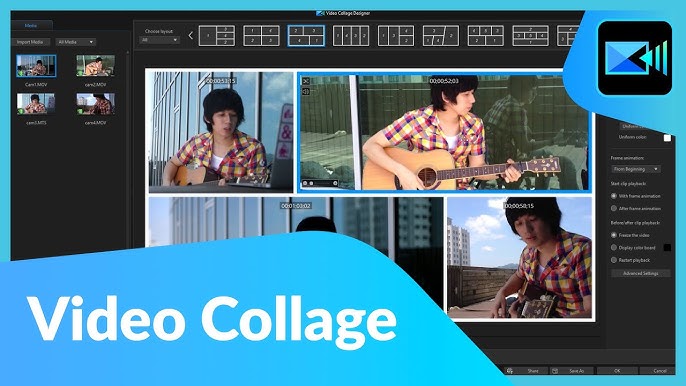
Creating a picture-in-picture (PiP) effect in PowerDirector allows you to overlay one video or image over another, enhancing storytelling and visual appeal in your videos. Whether you want to showcase multiple perspectives, provide commentary, or add context to your main footage, PowerDirector offers intuitive tools to achieve this effect with ease. This comprehensive guide will walk you through everything you need to know about creating a picture-in-picture effect in PowerDirector, covering basic setup, customization options, advanced techniques, troubleshooting tips, and more.
Understanding Picture-in-Picture (PiP) Effects
Picture-in-picture (PiP) is a video effect where one smaller video or image is displayed within another larger video frame. Key aspects of PiP effects include:
- Overlay: Placing one video or image layer over another.
- Size and Position: Adjusting the size, position, and opacity of the PiP layer.
- Animation: Adding transitions or animations to enhance visual impact.
PiP effects can be used creatively to emphasize content, provide additional context, or engage viewers with dynamic visual presentations.
Getting Started with Picture-in-Picture (PiP) in PowerDirector
Importing Media
- Open PowerDirector: Launch PowerDirector and start a new project or open an existing one.
- Import Media Files: Import both your main video footage and the secondary video or image you want to overlay as PiP into the Media Room.
Adding Footage to Timeline
- Drag Main Footage: Drag your main video clip from the Media Room to the timeline.
- Insert PiP Track:
- Right-click on the timeline and select “Insert Track” > “PiP Objects.”
- This creates a new PiP track above your main video track.
Basic PiP Effect Techniques
Adding PiP Object
- Add PiP Object:
- Click on “PiP Room” in the editing workspace to access PiP settings.
- Drag your secondary video or image from the Media Room to the PiP track on the timeline.
Adjusting Size and Position
- Resize PiP Object:
- Select the PiP object in the timeline.
- Use the handles around the object in the preview window to resize it.
- Positioning:
- Drag the PiP object to the desired position within the main video frame.
Opacity and Transparency
- Opacity Settings:
- Adjust the opacity of the PiP object to control its transparency.
- Use opacity settings to blend the PiP layer seamlessly with the main video.
Applying Transitions
- Transition Effects:
- Apply transition effects between the main video and the PiP object for smooth visual transitions.
- Drag and drop transition effects from the library onto the PiP object or the main video track.
Advanced PiP Effect Techniques
Animation and Keyframing
- Keyframing Movement:
- Use keyframes to animate the movement and position of the PiP object over time.
- Click on “Keyframe” mode, set keyframes at different points, and adjust position, size, or opacity.
Chroma Keying (Green Screen)
- Chroma Key Effect:
- Remove background from a PiP object using chroma keying.
- Click on “Fix/Enhance” > “Chroma Key” and select the background color to remove.
Masking and Cropping
- Masking Tools:
- Use masking tools to crop or reveal specific parts of the PiP object.
- Create custom masks to control where the PiP object appears within the main video frame.
Audio Integration
- Audio Settings:
- Adjust audio settings to control the volume and timing of audio from both the main video and the PiP object.
- Use audio tracks to synchronize audio between different PiP layers and main video content.
Tips for Effective Picture-in-Picture (PiP) Effects
Visual Hierarchy
- Hierarchy: Maintain a clear visual hierarchy between the main video and PiP objects for viewer clarity.
- Contrast: Ensure PiP objects contrast well with the main video background to avoid visual clutter.
Subtle Animations
- Animation Effects: Use subtle animations or transitions to introduce PiP objects without distracting from main video content.
- Timing: Align PiP animations with key moments or transitions in the main video for enhanced storytelling.
Consistency
- Design Consistency: Maintain consistent PiP design elements (e.g., size, position) throughout your video for visual coherence.
- Style: Match PiP effects to the overall style and theme of your video project for cohesive presentation.
Test Playback
- Preview: Playback your video to review PiP effects and ensure they appear as intended on different devices and screens.
- Adjustments: Make adjustments to PiP settings based on playback feedback to refine visual presentation.
Troubleshooting Picture-in-Picture (PiP) Issues
Alignment and Positioning
- Alignment: Ensure PiP objects are aligned correctly within the main video frame for consistent presentation.
- Gridlines: Use gridlines or alignment tools to guide precise placement of PiP objects.
Performance Optimization
- Rendering Settings: Adjust render settings to optimize PiP effect performance and maintain video quality during playback.
- Hardware Acceleration: Enable hardware acceleration for smoother editing and playback of PiP effects in PowerDirector.
Export Settings
- Export Format: Choose appropriate export settings to preserve PiP effect quality in final video output.
- Resolution: Match export resolution with original video resolution to avoid scaling issues with PiP objects.
Conclusion
Mastering the picture-in-picture (PiP) effect in PowerDirector allows you to enhance your video projects with dynamic overlays, creative visual storytelling, and engaging content presentations. By following the tools and techniques outlined in this guide, you can effectively integrate PiP objects into your videos, customize their appearance and behavior, and create professional-quality visual effects that captivate and inform your audience. Whether for tutorials, presentations, vlogs, or creative storytelling, PowerDirector’s versatile PiP tools empower you to explore and experiment with layered video compositions, elevate your video editing skills, and produce compelling videos that leave a lasting impression. Experiment with different PiP configurations, leverage advanced editing options, and unleash your creativity to craft impactful videos enriched with layered visual elements.